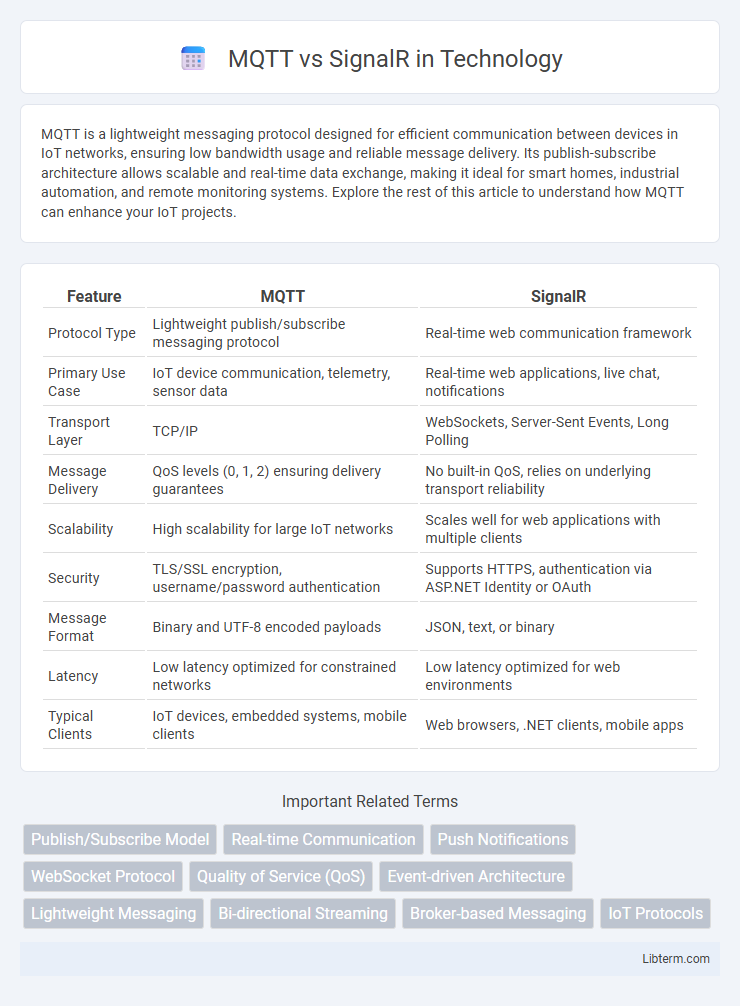MQTT is a lightweight messaging protocol designed for efficient communication between devices in IoT networks, ensuring low bandwidth usage and reliable message delivery. Its publish-subscribe architecture allows scalable and real-time data exchange, making it ideal for smart homes, industrial automation, and remote monitoring systems. Explore the rest of this article to understand how MQTT can enhance your IoT projects.
Table of Comparison
| Feature | MQTT | SignalR |
|---|---|---|
| Protocol Type | Lightweight publish/subscribe messaging protocol | Real-time web communication framework |
| Primary Use Case | IoT device communication, telemetry, sensor data | Real-time web applications, live chat, notifications |
| Transport Layer | TCP/IP | WebSockets, Server-Sent Events, Long Polling |
| Message Delivery | QoS levels (0, 1, 2) ensuring delivery guarantees | No built-in QoS, relies on underlying transport reliability |
| Scalability | High scalability for large IoT networks | Scales well for web applications with multiple clients |
| Security | TLS/SSL encryption, username/password authentication | Supports HTTPS, authentication via ASP.NET Identity or OAuth |
| Message Format | Binary and UTF-8 encoded payloads | JSON, text, or binary |
| Latency | Low latency optimized for constrained networks | Low latency optimized for web environments |
| Typical Clients | IoT devices, embedded systems, mobile clients | Web browsers, .NET clients, mobile apps |
Overview of MQTT and SignalR
MQTT is a lightweight, publish-subscribe network protocol designed for low-bandwidth, high-latency environments, commonly used in IoT applications for efficient message delivery between devices. SignalR is a real-time web communication framework developed by Microsoft that facilitates bi-directional communication between client and server, primarily for web applications requiring instant data updates. MQTT excels in resource-constrained scenarios, while SignalR is optimized for real-time, web-based interactive experiences.
Core Architecture Comparison
MQTT employs a lightweight publish-subscribe messaging protocol designed for constrained devices and low-bandwidth, high-latency networks, utilizing a central broker to manage message distribution efficiently. SignalR is built on a hub-based architecture that facilitates real-time bi-directional communication over HTTP and WebSocket protocols, primarily targeting web applications with direct client-server connections. MQTT excels in scalability and reliability for IoT scenarios, while SignalR specializes in seamless real-time updates for interactive web environments.
Protocols and Communication Models
MQTT operates on a lightweight publish-subscribe protocol designed for efficient message distribution in resource-constrained environments, primarily using TCP/IP for asynchronous communication between clients and brokers. SignalR relies on HTTP-based protocols like WebSockets, Server-Sent Events, and Long Polling to enable real-time, bi-directional communication in web applications with persistent connections between clients and servers. MQTT excels in decoupled, many-to-many communication scenarios ideal for IoT devices, whereas SignalR is optimized for server-to-client push messaging in interactive web applications.
Performance and Scalability
MQTT excels in lightweight, low-latency messaging ideal for IoT devices with limited network bandwidth, supporting millions of concurrent connections through its efficient publish-subscribe model. SignalR provides robust real-time web communication by utilizing WebSockets and fallbacks, but its performance can be impacted by higher resource consumption and server load in large-scale applications. Scalability for MQTT is enhanced by brokers designed for distributed clusters, while SignalR often requires complex scaling strategies like Azure SignalR Service or Redis backplanes to manage extensive user connections efficiently.
Security Features and Authentication
MQTT supports TLS encryption for secure data transmission and offers username/password authentication alongside optional client-side certificates, making it suitable for IoT environments with constrained devices. SignalR integrates with ASP.NET Core's robust authentication mechanisms, including OAuth, JWT tokens, and cookie-based authentication, ensuring strong security in real-time web applications. Both protocols provide message integrity and confidentiality, but MQTT's lightweight approach excels in resource-constrained scenarios while SignalR offers comprehensive support for complex user authentication and authorization workflows.
Use Cases and Applications
MQTT excels in Internet of Things (IoT) environments by enabling lightweight, low-bandwidth messaging ideal for sensor networks, home automation, and industrial telemetry. SignalR is better suited for real-time web applications requiring immediate bi-directional communication like live chat, gaming, and dashboards. Both protocols support real-time data exchange, but MQTT prioritizes efficient message delivery over constrained networks, while SignalR emphasizes seamless integration with ASP.NET applications and web clients.
Cross-Platform and Device Support
MQTT supports a wide range of platforms and devices, including embedded systems, IoT devices, mobile apps, and desktop environments, making it ideal for constrained environments with limited resources. SignalR primarily targets web applications and .NET ecosystems, offering seamless real-time communication for web browsers, Windows, and some mobile platforms but has limited support for non-Microsoft and low-power devices. MQTT's lightweight protocol and broad cross-platform compatibility make it the preferred choice for large-scale, heterogeneous device networks.
Ease of Implementation and Integration
MQTT offers a lightweight protocol optimized for IoT environments, featuring straightforward implementation with minimal overhead, making it ideal for resource-constrained devices and seamless integration with sensor networks. SignalR, designed for real-time web applications, provides built-in support for multiple transport protocols, allowing easy integration with ASP.NET frameworks and rapid setup using high-level APIs. Developers prioritize MQTT when working with low-bandwidth scenarios and SignalR for complex interactive web applications requiring bi-directional communication.
Pros and Cons of MQTT and SignalR
MQTT excels in lightweight, low-bandwidth communication suited for IoT devices, offering efficient message delivery with a publish-subscribe model but may lack built-in security features and can be complex to implement across varied platforms. SignalR provides real-time web functionality with seamless integration in ASP.NET ecosystems, offering automatic connection management and scale-out support, yet it can consume more resources and may not be as optimized for constrained environments as MQTT. Choosing between MQTT and SignalR depends on factors such as network constraints, device capabilities, required message patterns, and specific application architecture.
Choosing the Right Solution
Choosing between MQTT and SignalR depends on the specific use case and communication requirements. MQTT excels in lightweight, low-bandwidth environments with resource-constrained devices, making it ideal for IoT applications requiring reliable, asynchronous messaging over unreliable networks. SignalR is better suited for real-time web applications that need persistent, bi-directional communication with high throughput and low latency, such as live chat or gaming platforms.
MQTT Infographic

 libterm.com
libterm.com